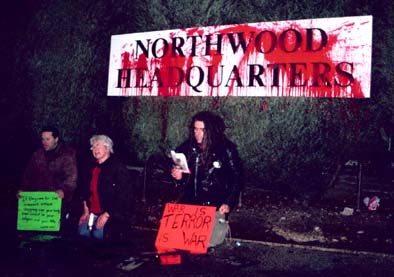 English
English Español
Español
Northwood Headquarters
A look at the centre of British military interventions

Situated in the London suburb of Northwood, conveniently accessible for activists via the Metropolitan line, is the Northwood Headquarters, also known as HMS Warrior. From the outside it is not visible that Northwood Headquarters play a crucial role in the more and more interventionist military strategies of Britain - or more generally NATO and the Western countries. This article takes a closer look at the role of Northwood Headquarters, firstly at Northwood's role within the NATO command structure, and at the Permanent Joint Forces Headquarters at Northwood.
Northwood Headquarters is not just one headquarters - it consists of several headquarters with specific roles. At present they are:
- NATO Regional Command East Atlantic (RC EAST)
- NATO Component Command Naval Forces North (NAVNORTH)
- British Permanent Joint Forces Headquarters (PJHQ) (1)
The National Command of Fleets (CINCFLEET) was based at Northwood too, but moved to new headquarters at Whale Island, Portsmouth. Only a few staff remain at Northwood. (2)
Northwood & NATO
NATO's history with Northwood began in 1952, when the NATO Eastern Atlantic Command moved to Northwood. Nowadays Northwood plays a double role within NATO's command structure (see graphics): As NATO Regional Command East Atlantic (RC EAST) it is part of the Allied Command Atlantic (ACLANT), based in Norfolk, Virginia, USA. According to the NATO website, "the primary task of ACLANT is to contribute to security in the Atlantic area by safeguarding the Allie's sea lines of communication, supporting land and amphibious operations, and protecting the deployment of the Alliance's sea based nuclear deterrent". (3)
In addition, Northwood is part of the structure of the Allied Command Europe (ACE), based in Mons, Belgium. ACE is responsible for the whole are from the Northern tip of Europe to the South, including the whole Mediterranean region from the Atlantic coastline to the eastern border of Turkey. Here Northwood has a sub-regional responsibility as Component Command Naval Forces North under Regional Command North.
According to NATO, "this link is a crucial element of NATO's ability to conduct joint operations effectively in Europe". (4) And: "In response to the end of the Cold War and the advent of Partnership for Peace (PfP), NATO reviewed its infrastructure and defence plans to prepare it to face the rather more diverse risks inherent to the post-Cold War period. This has led to expanded roles and tasks for the combined Regional Headquarters East Atlantic and Headquarters Allied Naval Forces North". (5)
These "more diverse risks" are described in NATO's new strategy, which was passed during NATO's war on Yugoslavia in 1999. Besides war, nuclear and conventional weapons, and access to natural resources, NATO defines security risks as follows: "However, Alliance security must also take account of the global context. Alliance security interests can be affected by other risks of a wider nature, including acts of terrorism, sabotage and organised crime, and by the disruption of the flow of vital resources. The uncontrolled movement of large numbers of people, particularly as a consequence of armed conflicts, can also pose problems for security and stability affecting the Alliance." (6)
Northwood is part of the response to these "security risks", and plays a crucial role for NATO operations within Western Europe. This might become even more important in the near future, when the European Union develops its military wing, which probably will involve the use of NATO assets for EU military operations. Northwood then will be part of European Union military interventions.
Permanent Joint Headquarters (PJHQ)
"As well as 24 surface ships and two nuclear-powered submarines, more than 2,000 British troops have already been deployed in Oman, a figure that will rise to 24,000 - nearly a quarter of the British army - by the end of the month. They will be supported by 400 armoured vehicles, squadrons of fighter-bombers, and a Commando brigade. Their role will be to intervene in a war that began in the early hours of July 9 when the first hostile tanks crossed the border, their tracks thundering across the sweltering desert plains of northern Oman." (7) What Jamie Wilson and Richard Norton-Taylor describe here in a Guardian article was Britain's biggest ever military exercise, called Saif Sareefa, and marked the full operationallity of the Permanent Joint Forces Headquarters in Northwood, and the Joint Rapid Reaction Force (JRRF).
It might not be a coincidence that this huge war game - and commando exercise - took place in Oman, a desert region with a climate similar to Iraq.
Effective military interventions
Northwood - the PJHQ - is the result of efforts to improve effectiveness of military operations. The 1994 Defence Cost Study lead to the requirement to separate policy from operations, a consequence of which would be the creation of the Permanent Joint Headquarters. It recommended permitting "a proper, clear, and unambiguous connection between [government] policy and strategic functions and the conduct of operations at the operational level to be achieved". In July 1994, the creation of a single, permanent joint headquarters under a chief of joint operations (CJO) was announced. At the same time the formation of a rapid deployment force was announced. Both should become operational by April 1996 (8).
Phase 1 of these developments was completed in 1999. Culmination of phase 2 - development of the full capability - was supposed to be Exercise Saif Sareefa. If this exercise went ahead as planned - after 11 September 2001 - is not known to me.
Joint Force Headquarters Deployments
| Operation | Location | Timeframe |
| Caxton | Montserrat | March 1996 |
| Purposeful | Central Africa | November-December 1996 |
| Determinant | Congo/Zaire | March-June 1997 |
| Alleviate | Albania | June-July 1997 |
| Bolton | Kuwait | February-April 1998 |
| Carrick | Indonesia | May-June 1998 |
| Ladbrook | Congo | August-September 1998 |
| Desert Fox | Middle East | December 1998 |
| Basilica | Sierra Leone | January-February 1999 |
| Agricola | Kosovo | June 1999 |
| Langar | East Timor | September-December 1999 |
| Barwood | Mozambique | February-March 2000 |
| Palliser | Sierra Leone | May-June 2000 |
"Jointery" is the new buzzword, and the Permanent Joint Headquarters is one of the consequences. While joint operations are not entirely new - the Falklands war was a joint operation - but before 1996 the command structures for joint operations were always set up on an ad hoc basis, with those in command who seemed to be most approproate. The Falklands war was commanded from the Fleet Headquarters, then at Northwood, and the Gulf War 1991 was commanded by the Royal Air Force Strike Command Headquarters at High Wycombe. This was often inefficient - and long-term joint planning didn't happen. In 1996 PJHQ put an end to this (9).
Joint Command & Control Structures
The PJHQ are commanded by the Chief of Joint Operations. The role of Northwood is "to be responsible … for the planning and execution of U.K.-led joint, potentially joint, combined, and multinational operations, and for exercising operational command of U.K forces assigned to combined and multinational operations led by others, in order to achieve military strategic objectives." (8)
In order to be able to do so, Northwood permanently plans and evaluates. It classifies conflicts in four categories - quiescent, stirring, quickening, and surfaced - which then lead to three categories of interest. At the lowest level - which probably includes the whole world - "intelligence is maintaining a watching brief on areas of operational interest and creating a priority list". If it is evident that a crisis is emerging, then a multidisciplinary contingency planning team is organised, which is expected to master the situation in order to advice the entire chain of command. The third level of interest - and we can be sure Iraq is on that level right now - involves the formation of an operations team. Their role is to deal with the details of command, deployment and sustenance of forces, and ultimately the recovery of the assigned forces. In addition it has to be proactive and responsive towards the Ministry of Defence and supporting commands (8).
Outlook
If - which we all hope won't happen - in some months/weeks time the US and Britain will attack Iraq, then PJHQ at Northwood will be the centrepiece of the British part of this aggression. The plans are drawn up now - at Northwood.
If we want to stop a war on Iraq - and I hope we do - then Northwood is one important "target" for our activities. Not only it is conveniently accessible via the Metropolitan line, but even more so because it plays the crucial role in any British military operation overseas. Northwood is the heart of the (military) beast - meet you soon at Northwood?
Andreas Speck is an activist with the antimilitarist direct action group D10, and is on the staff of War Resisters' International.
Notes:
(1) http://localhost and http://localhost
(2) https://www.navynews.co.uk
(3) http://localhost
(4) http://localhost
(5) http://localhost
(6) The Alliance's Strategic Concept, Approved by the Heads of State and Government participating in the meeting of the North Atlantic Council in Washington D.C. on 23rd and 24th April 1999, Press Release NAC-S(99)65, 24 Apr. 1999
(7) British forces flex military muscle for £93m 'desert war'. The Guardian, 3/11/2001
(8) Richard M Connaughton: Organizing British Joint Rapid Reaction Forces. Joint Forces Quarterly, Autumn 2000, p87-94
(9) Jeremy R. Stocker: Jointness in Defence of the Realm. Joint Forces Quarterly, Spring 1997, p137-140
- Log in to post comments
